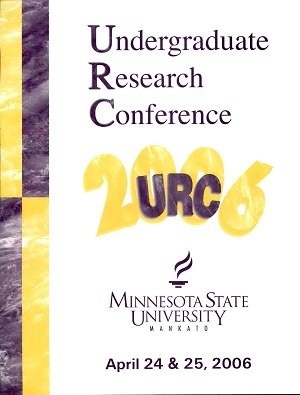Immunolocalization of Actin in Transgenic and Wildtype Murine Myocardium
Location
CSU North Ballroom
Start Date
25-4-2006 10:00 AM
End Date
25-4-2006 12:00 PM
Student's Major
Biological Sciences
Student's College
Science, Engineering and Technology
Mentor's Name
Marilyn C. Hart
Description
In myocardium, actin and myosin filaments are organized into repeating units of sarcomeres, the basic unit of muscle contraction. Actin Capping Protien (CP) binds to the barbed ends of the actin filament at the Z-line, directing and maintaining the proper organization of the thin filament in the sarcomere. CP is a heterodimer composed of an alpha (α) and a beta (β) subunit. Muscle cells contain two β subunit isoforms, β1 and β2. The β1 isoform is present at the Z line; the β2 isoform is found elsewhere, including cell-cell junctions such as intercalated discs and myotendinous junctions and at the cortical regions underlying the plasma membrane in general. In previous studies, transgenic mice were generated that replaced the β1 isoform of CP with the β2 isoform of CP using the cardiac-specific promoter of the α-myosin heavy chain (α-MyHC) gene. We hypothesized that a decrease in β1 expression will lead to a disorganized myofibrillar structure and that the disorganization will become increasingly severe as a function of murine age. Murine hearts were extracted, frozen in liquid nitrogen and rinsed with IX Phosphate Buffer Saline (PBS). Frozen sections were prepared using a cryomicrotome and collected on gelatin coated slides. The tissue sections were fixed in 0.1% paraformaldehyde in PBS, quenched with ethanolamine, permeabilized with methanol, and washed in PBS. The sections were probed with mouse anti-actin primary antibody and anti-mouse IgG rhodamine conjugated secondary antibody. Our results support our hypothesis. Immunofluorescence studies revealed an increasing disorganization as a function of murine age.
Immunolocalization of Actin in Transgenic and Wildtype Murine Myocardium
CSU North Ballroom
In myocardium, actin and myosin filaments are organized into repeating units of sarcomeres, the basic unit of muscle contraction. Actin Capping Protien (CP) binds to the barbed ends of the actin filament at the Z-line, directing and maintaining the proper organization of the thin filament in the sarcomere. CP is a heterodimer composed of an alpha (α) and a beta (β) subunit. Muscle cells contain two β subunit isoforms, β1 and β2. The β1 isoform is present at the Z line; the β2 isoform is found elsewhere, including cell-cell junctions such as intercalated discs and myotendinous junctions and at the cortical regions underlying the plasma membrane in general. In previous studies, transgenic mice were generated that replaced the β1 isoform of CP with the β2 isoform of CP using the cardiac-specific promoter of the α-myosin heavy chain (α-MyHC) gene. We hypothesized that a decrease in β1 expression will lead to a disorganized myofibrillar structure and that the disorganization will become increasingly severe as a function of murine age. Murine hearts were extracted, frozen in liquid nitrogen and rinsed with IX Phosphate Buffer Saline (PBS). Frozen sections were prepared using a cryomicrotome and collected on gelatin coated slides. The tissue sections were fixed in 0.1% paraformaldehyde in PBS, quenched with ethanolamine, permeabilized with methanol, and washed in PBS. The sections were probed with mouse anti-actin primary antibody and anti-mouse IgG rhodamine conjugated secondary antibody. Our results support our hypothesis. Immunofluorescence studies revealed an increasing disorganization as a function of murine age.
Recommended Citation
Davis, Jacob R. and Meghan Bohland. "Immunolocalization of Actin in Transgenic and Wildtype Murine Myocardium." Undergraduate Research Symposium, Mankato, MN, April 25, 2006.
https://cornerstone.lib.mnsu.edu/urs/2006/poster-session-E/9



